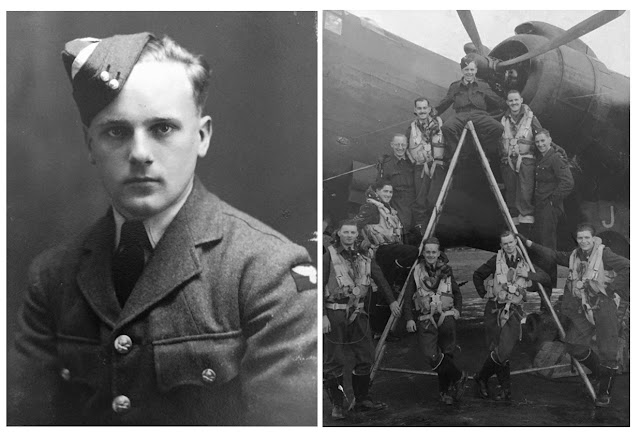RAF Casualties in Swansea
This
November marks the 99th anniversary of the ceasefire on the Western Front and
the 98th anniversary of Remembrance Sunday
To coincide with the 2018, 100th anniversary of the Cease Fire, I am
working on producing new research material which will be found both in the
Central Library (Reference) and the Mormons Church, Cockett Road.
The research work, First World War, will consist of all the Swansea men
who fought and died whilst serving with the British Army, Royal Navy,
Mercantile Navy, and Royal Flying Corps/Royal Air Force. I will also try to
establish what the individual’s occupations were prior to the war using the
Military Records and the 1911 Census Records.
Gower
bore witness to over 30 plane crashes from October 1939 to February 1946.
Whilst visiting St. Hilary’s Church, Killay, during the summer, I
discovered that there are 24 Royal Air Force/Royal Air Force Volunteer Reserve,
(RAFVR) graves. The RAFVR was formed in
1936. Three men, Sergeant E. H. Dawe (23), Sergeant E. T. A. Deacon (25), and Pilot Officer R. P. Fahrini (21) all died on the same
day, 19th August 1942. They belonged to the No. 172 Squadron, formed in 1942,
based at R.A.F Fairwood Common (Fairwood took over a year to be built and was
finally operational in June 1941. During the period of June 1941 to March 1947
there were over 66 squadrons/flights that operated from the aerodrome).
I conducted further research on No.
172 Squadron, and discovered that on that particular day, 19th August, there
were four more deaths, J. Mullins, buried
in Macclesfield Cemetery, F. P. C. Cross,
buried in Aldershot Civil Cemetery, G. C. V. Jamieson,
buried in Canford Cemetery, Bristol and J. S. Haynes, buried
in Preston Cemetery, Tynemouth. They had been on board the Wellington VIII,
‘Leigh Light’ Bomber.
This is how the events of the morning,
19th August 1942 unfolded.
Pilot Jamieson,
took off from Fairwood, on a test and demonstration along with 8 people,
including an US Army Officer and one ground crew. The aircraft was unarmed
apart from a gun turret. The aircraft was flying over Swansea Bay, when she was
mistakenly attacked by the anti-aircraft gunners on board the US tanker Gulf of Mexico which was in the Bristol
Channel. Those on board didn’t have time to bail out and the Wellington caught
fire before crashing into the sea a mile west of Scarweather Point, Porthcawl.
The next day the US Gulf of Mexico,
docked at Milford Haven and claimed that it had carried out instructions in
accordance with the CAMSI (Confidential Admiralty Merchant Shipping
Instructions). Sadly, the ship seems to have gone off the radar as I can’t find
any trace of it. The plane wreck remains in Swansea Bay, protected by The Protection of Military Remains Act, 1986.
British servicemen who lost their
lives at home during the Second World War were often repatriated to their home
town to be buried, but this wasn’t the case for foreign men, they were often
buried at the local cemetery/graveyard, for example St. Hilary’s, Killay. I
applied for the death certificates of the three men who are laid to rest in St.
Hilary’s. The results were very interesting. Fahrini’s couldn’t
be found. Deacon’s was a military
certificate giving the cause of death as an ‘aircraft accident’ and Dawes’ was an ordinary certificate, which stated
that he died from multiple injuries and drowned due to accident whilst on
Operational Flight. The sea being a cruel mistress, his body was located 160
degrees off Mumbles Head, west of Lundy Island.
The Dieppe Raid was also launched on
the 19th August 1942, and one of those pilots giving support to the
Canadian Forces was Pilot Officer D. Iverach. On 23rd
August Iverach was flying a Spitfire MK VB and practising
dog fighting tactics with another spitfire, when his aircraft started a long
dive. An eye-witness, Emrys Jones, of Great Lunnon
Farm, Parkmill, Gower whilst out cycling watched the aircraft’s descent, hoping
that the pilot would pull up. The dive of over 6,000 ft turned into a spin, and
the plane came down on Cefn Bryn Common. To Jones’ surprise
the plane was still intact, the pilot, Iverach, was dead
slumped forward in the cockpit.
D. Inverach was a member
of the No. 421 Squadron, a unit of the Royal Canadian Air Force which was also
based at RAF Fairwood Common. He was the squadron’s first
casualty since its formation in 1942. He is also buried at St. Hilary’s Church,
Killay.
Since the publication of Dunkirk and its local connections, in September’s 2017
Bay magazine, Mr Charles Drewson, the last
surviving veteran of Dunkirk from Swansea has sadly died aged 95.
Copyright – The Bay Magazine – Winter 2017







Comments
Post a Comment